
If you've been reading articles about dating a vintage guitar, you may well have come across mention of pot codes, and the concept of using pot codes to date your guitar. The pots, or potentiometers to give their full name, are the variable resistors that control volume and tone. Better quality pots are often stamped with a number of codes; typically part numbers, date of production, manufacturers codes and resistance values. Many pots don't carry all of this information, but the better quality guitars produced in America usually do.
So where are these codes? Normally they are stamped or inked onto the back or sides of the pot. So reading them will require opening control cavities, removing scratchplates, or in the case of a semi acoustic, removing the pots entirely. Codes can be faded, worn, obscured by solder and other components, or simply very small. Finding them is not always easy; this is obviously not something for the faint-hearted, but once performed a few times, nowhere near as daunting as it might at first seem. There are many exceptions and variations to the general rules described below, some of which are highlighted in the examples at the end. But read on, dating a vintage guitar with pot codes is sometimes more reliable than dating with serial numbers!
Many pots do not have part numbers, but the larger guitar manufacturers did list pots by part number in their spare parts manuals. You can look up Gibson potentiometers by their part number in the Gibson pot index on this site.
There are very many electronic companies worldwide producing potentiometers, but most American vintage guitars of the 20th Century used pots by just a few manufacturers. American pot manufacturers had their own numerical EIA (Electronic Industries Alliance) codes, for example 134 = Centralab, 137 = CTS and 304 = Stackpole. Although many others were used, these are by far the most important, as they were widely used by the likes of Gibson, Fender, Guild and Epiphone. Other worldwide manufacturers just used the company name rather than a code. Some also put a country of production.
Production dates regularly appear on potentiometers, though usually encoded to some extent. Each company had it's own dating system, although there was some consensus, particularly in American parts. Other companies from around the world used different systems using letters to denote differing years and months. Sometimes these are simple, sometimes exceptionally complicated (for no useful reason!).
Date codes were usually in three or four digits, one or two digits giving the year (for many US pots one digit refers to the 1950s, two digits to the 1960s), and two giving the week of the year. These often run on from the manufacturer code. For example 1346120 is a Centralab pot (134) produced in the 20th week of 1961. These are some of the simplest codes to read, and it is therefore unsurprising that this system has become standard.
Egen Electric Limited were a British electronics supplier whose pots were widely used in guitars by Vox, Fenton Weill, Hohner and others. They do not use an EIA code, but are easily identifiable, typically having EGEN stamped onto the top of the pot (next to the shaft) and a tape covering the data on the side of the pot. Egen potentiometers have a simple two letter date code in the format MY (although occasionally they used YM). The month code ran A-I (Jan-Dec). The year code may not encompass the entire alphabet (then again it may), but the most relevant section covering British guitar construction (early-mid 1960s) ran H-O (1960-1967). So an Egen date code of 'JK' means October 1963 (J = October, K= 1963).
| code | month | code | year |
|---|---|---|---|
| A | Jan | G | 1959 |
| B | Feb | H | 1960 |
| C | Mar | I | 1961 |
| D | Apr | J | 1962 |
| E | May | K | 1963 |
| F | Jun | L | 1964 |
| G | Jul | M | 1965 |
| H | Aug | N | 1966 |
| I | Sep | O | 1967 |
| J | Oct | ||
| K | Nov | ||
| L | Dec |
Morganite pots were commonly fitted to British Vox guitars. Although they do not have an EIA manufacturer code, they are quite distinctive - small (about 3/4" diameter), with a brown plastic back with Morganite in raised lettering. Interestingly, these pots used more than one dating system, sometimes using numerals in the format WWY (typically early 1960s), and sometimes, a letter-based format, similar to the Egen codes above. However these were in the format YM (but, as with the Egen codes, they occasionally switched the letters to a MY format!). The month code differed from Egen, above, in that the letter I was skipped - to prevent confusion with the number 1 - so it ran A-M (Jan-Dec). Year codes for the relevant period ran S-X (1961-1967). Interestingly, some examples even had both a numeric and letter-based codes on the same pot. For example, a pot labelled 'TL 1MΩ LOG 462' had the numeric date code 462 (46th week of 1962 NOT 4th week of 62), and the alphabetical code TL (T = 1962, L= November).
| code | year | code | month |
|---|---|---|---|
| S | 1961 | A | Jan |
| T | 1962 | B | Feb |
| U | 1963 | C | Mar |
| V | 1964 | D | Apr |
| W | 1965 | E | May |
| X | 1966 | F | Jun |
| G | Jul | ||
| H | Aug | ||
| J | Sep | ||
| K | Oct | ||
| L | Nov | ||
| M | Dec |
Pot dates can be a useful tool in dating guitars. But remember this is the date that the potentiometer was produced. Pots in an older guitar may have been replaced, and this should be considered, especially if the date suggested does not fit with other features of the guitar. What's more, guitar companies sometimes took a very long time to use the potentiometer in question, and they may be considerably older than the guitar itself. Fender, famously bought huge stocks of pots in 1966, and took almost a decade to use them all. Conversely, guitars were also built, but not wired and shipped immediately, resulting in newer pots in older guitars. This is especially the case for guitars that were only ever shipped in tiny numbers. Pot dates are a useful tool in guitar dating, but should always be used in conjunction with other known factors, such as hardware changes and serial numbers.
Resistance values are normally listed. 250k, 500k and 1 Meg (1000k) being the most common. The taper of a pot describe how the resistance changes with the turning of the pot. The words LIN on a pot means a linear taper; turned half way, the resistance is at approx. 50% of maximum, three quarters of the way at 75% of maximum etc. Pots marked LOG or AT (which stands for audio taper) change logarithmically. As a general rule, volume pots have a logarithmic taper, and tone pots have a linear taper.


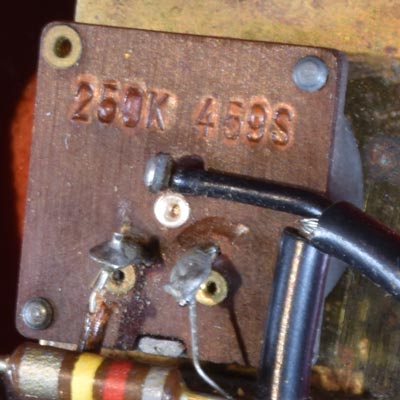
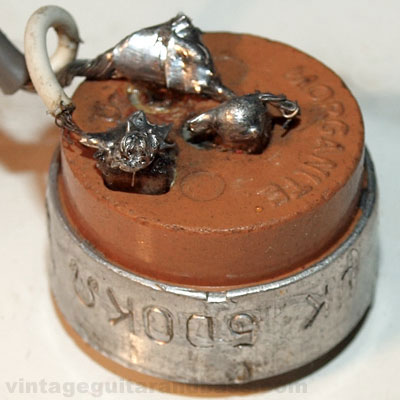
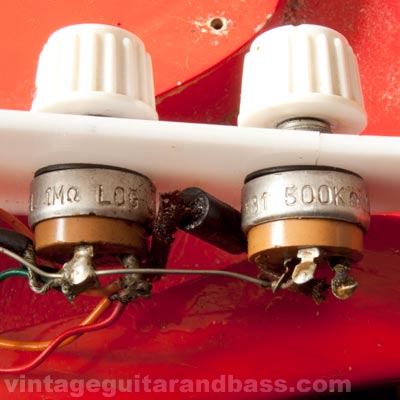
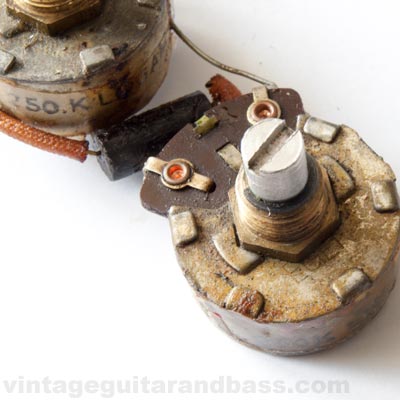
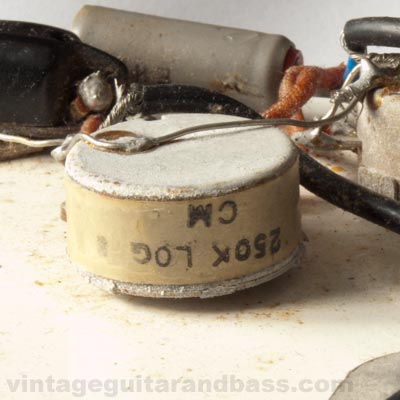
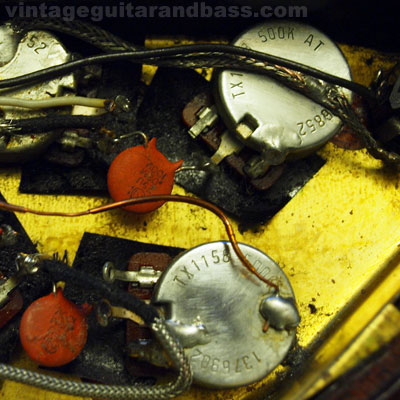
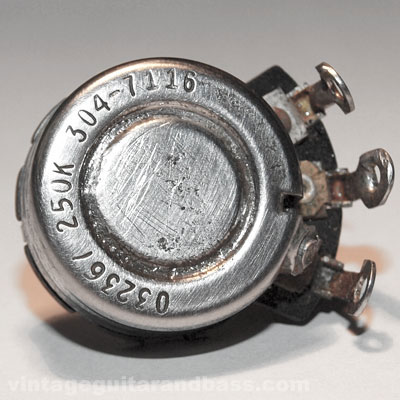

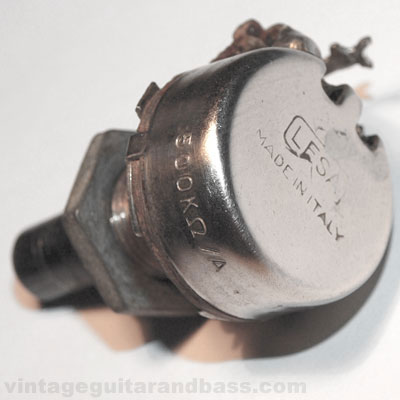
$495
$599
$180
$1269
$240
$199
$99
$38
$69
$260